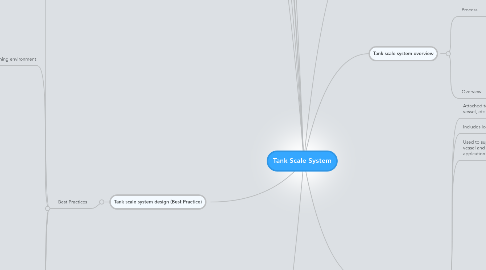
1. Tank scale system performance
1.1. Accuracy = Terminal + Vessel + Weigh Modules
1.1.1. Reality
1.2. Resolution = Terminals ability to calculate and display
1.2.1. Purely an electronic function
1.2.1.1. "Fantasy"
1.3. Performance
1.3.1. +- .01% (59-77degF)
1.3.2. +- .015% (50-86degF)
1.3.3. +- .033% (14-104degF)
1.3.4. Important to calibrate first!
2. Tank scale system design (Best Practice)
2.1. Best Practices
2.1.1. 1 - Start with high quality load cell sensors
2.1.1.1. Use Certified, legal for trade
2.1.1.2. NTEP (USA)
2.1.1.3. OMIL (Europe and ROW)
2.1.1.4. VCAP (USA)
2.1.1.5. Goal- .02% Error or better
2.1.1.6. Material
2.1.1.6.1. Stainless Steel Alloy (Best)
2.1.1.6.2. 420 Steel (Better)
2.1.1.6.3. Alloy Steel (Good)
2.1.2. 2 - Control the weighing environment
2.1.2.1. Wet or corrosive environmetns?
2.1.2.1.1. Stainless Steel!
2.1.2.1.2. Run through conduit
2.1.2.1.3. Teflon cables protect
2.1.2.2. Extreme Temperatures?
2.1.2.2.1. Can result in false weight readings
2.1.2.2.2. Can damage equipment
2.1.2.2.3. Compensated temp range (legal for trade)
2.1.2.2.4. Operating temperature range
2.1.2.2.5. Use isolation pad to avoid transfer
2.1.2.2.6. Use Heat Shield to protect against radiant heat
2.1.2.3. Shocks/loading vibration?
2.1.2.3.1. Can be damaging to load cells
2.1.2.3.2. Use shock pad
2.1.2.3.3. Increase damping
2.1.2.3.4. Vibration can lead to instability
2.1.2.3.5. Can use DSP (digital signal processing)
2.1.2.4. Wind loading?
2.1.2.4.1. Can cause extra tension or compression on cells
2.1.2.4.2. Distriubution
2.1.2.4.3. Pressure differentials
2.1.2.4.4. Overturning moments and horizontal shear forces
2.1.2.5. Earthquakes?
2.1.2.5.1. Geographical consideraton
2.1.2.5.2. Create Priority and Secondary waves
2.1.2.5.3. Act at Centroid of system
2.1.2.5.4. Use reaction forces compared to maximum ratings
2.1.2.6. Lightining/Surges
2.1.2.6.1. Use 'dummy' load cells during construction
2.1.2.6.2. DO NOT Ground through the load cells
2.1.3. 3 - Control the load application point
2.1.3.1. Load in the "sweet spot"
2.1.3.1.1. Must be transmitted consistently and correctly
2.1.3.2. Sensitive to movement
2.1.3.3. Control
2.1.3.3.1. 1 - Pick right SUSPENSION
2.1.3.3.2. 2 - Properly SUPPORT
2.1.3.3.3. 3 - Use proper PIPING in and out of tank
2.1.3.4. Static vs Dynamic
2.1.3.4.1. Static - Tanks, SIlos, Vessels, Hoppers
2.1.3.4.2. Dynamic - Horizontal shear transmitted into load cell
2.1.3.5. Suspension
2.1.3.5.1. Rigid
2.1.3.5.2. Sliding
2.1.3.5.3. Self Aligning
2.1.3.6. Pipe selection
2.1.3.6.1. Flexible pipe
2.1.3.6.2. Reduce pipe against load cell
2.1.3.6.3. Don't want to anchor pipe vertically
2.1.4. 4 - Size the weigh modules correctly
2.1.5. 5 - Install the weigh modules correctly
2.1.6. 6 - Properly calibrate
3. Determining weigh module quantity & capacity
3.1. Weigh Module Quantity
3.1.1. 3 or 4 or more support?
3.1.1.1. 3 Support
3.1.1.1.1. Ideal
3.1.1.1.2. Easy of weight distribution
3.1.1.2. 4 Support
3.1.1.2.1. More stability
3.2. Find out tank weight and all attachments
3.3. Find net weight of content
3.4. Orientation of Weigh Modules
3.4.1. Like This
4. Weigh Module installaton
4.1. Install wise to the weather elements
4.2. Don't attach directly to the tahnk
5. Calibration
5.1. 4 Basic methods
5.1.1. 1 - Use certified test weights
5.1.2. 2 - Test weights and material substitution
5.1.3. 3 - Material Transfer (vessel to vessel)
5.1.4. 4 - CalFREE Auto calibrate
6. Application Support Tools
6.1. Test
7. Q & A
8. Decision to use weighing technology
8.1. -Versatile technology
8.2. -Accuracy better than .5% (example +- 5lbs in a 1000lbs tank)
8.3. -Good for conical vessels
8.4. TRADE-OFFS
8.4.1. Higher initial cost
8.4.1.1. extra design effort
8.4.1.2. extra structural consideration
8.4.1.3. Requires "know-how" to get working right
8.4.1.4. Disables multi-ingredient batching
9. Tank scale system overview
9.1. Process
9.1.1. FIlling
9.1.2. Dosing
9.1.3. Catching
9.1.4. Formulation
9.1.5. Bulk Inventory
9.2. Overview
9.2.1. Sensor Level
9.2.1.1. Signal Generation
9.2.1.1.1. Strain Gauge Load Cell
9.2.1.1.2. Weigh module assembly
9.2.2. Signal Processing Level
9.2.2.1. Converts raw signal from load cells to raw
9.2.2.2. Sends data to PLC or other medium
9.2.3. GIGO - Garbage in Garbage out
9.2.3.1. Must pay attention to proper application and installation of load cell-based sensors
10. Tank weigh modules defined
10.1. Attached to a tank, hopper, vessel, etc and convert to scale
10.2. Includes load cell and all mounting hardware
10.3. Used to support a weighing vessel and control the load applcation
10.4. Two basic types
10.4.1. Compression
10.4.1.1. Beam type load cell
10.4.1.2. Receiving plate
10.4.1.3. Pin direction
10.4.1.4. USE IF
10.4.1.4.1. Must stand on floor or the ground
10.4.1.4.2. Passes through a floor or mezzanine
10.4.1.5. Advantages
10.4.1.5.1. Biggest type of choices and capacities
10.4.1.5.2. Up to 660k (300t)
10.4.1.5.3. Great flexibility
10.4.1.5.4. Best suited overall
10.4.2. Tension
10.4.2.1. USE IF
10.4.2.1.1. Existing overhead module
10.4.2.1.2. Floor must stay clear
10.4.2.2. Advantages
10.4.2.2.1. Easy install
10.4.2.2.2. Good performance
10.4.2.2.3. No floor space occupation
10.4.2.2.4. Thermal isolation from hot tanks
10.4.2.2.5. Gravity discharge
10.4.2.3. Disadvantages
10.4.2.3.1. Only 20k (10t)

